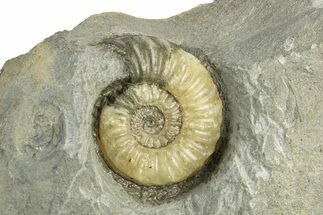This Specimen has been sold.
.89" Ammonite (Promicroceras) Fossil - Lyme Regis
This is a very beautiful Promicroceras planicosta ammonite fossil which has been replaced with a golden calcite, collected from the Lyme Regis region of England. It's almost translucent and has been nicely prepared in a way that unveils the crystal formations within. It displays very well on the limestone slab and comes with an acrylic display stand.
About Ammonites
Ammonites were ancient marine cephalopods, similar to today's squids and octopuses, but with a defining feature: their distinctive, tightly coiled spiral shells. These shells, resembling those of modern nautiluses, served as both a protective home and a buoyancy aid, allowing ammonites to navigate the prehistoric seas with ease. First emerging around 240 million years ago in the Triassic Period, ammonites thrived for over 175 million years, adapting through numerous forms and sizes. As predatory creatures, they likely fed on smaller marine organisms, using their tentacles to capture prey. However, their long reign came to an end 65 million years ago at the close of the Cretaceous, coinciding with the mass extinction event that also eliminated the dinosaurs.
Ammonites were ancient marine cephalopods, similar to today's squids and octopuses, but with a defining feature: their distinctive, tightly coiled spiral shells. These shells, resembling those of modern nautiluses, served as both a protective home and a buoyancy aid, allowing ammonites to navigate the prehistoric seas with ease. First emerging around 240 million years ago in the Triassic Period, ammonites thrived for over 175 million years, adapting through numerous forms and sizes. As predatory creatures, they likely fed on smaller marine organisms, using their tentacles to capture prey. However, their long reign came to an end 65 million years ago at the close of the Cretaceous, coinciding with the mass extinction event that also eliminated the dinosaurs.
SPECIES
Promicroceras planicosta
LOCATION
Lyme Regis, Dorset, England
FORMATION
Lower Lias, Obtusum Zone
SIZE
Ammonite .89" wide, Rock 3.3 x 2.4"
CATEGORY
SUB CATEGORY
ITEM
#103020
We guarantee the authenticity of all of our specimens.
 Reviews
Reviews












